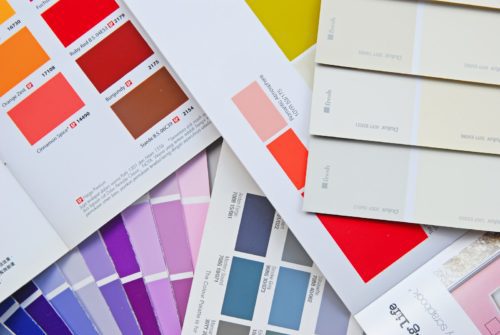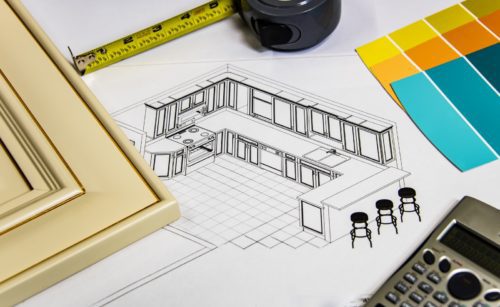Bright Kitchens: Color Me Impressed!
March 13, 2018Vivacious use of color is in! It’s big and it’s worth it! Today, let’s walk through the science behind color, why color is vital to creating the space you truly want, and how to implement individualized room colors without overdoing it!
Room Colors: The Basics of Color
What exactly is color? Color is an attribute of an object as it is perceived by sight. When light hits an object, different parts of that object reflect the light differently. That reflected light and the different kinds of reflections are translated by the eye and brain into colors.
A rainbow is a great example of color reflection. Have you ever seen tiny water droplets in the air reflect sunlight at just the right angle to create a prismatic spectrum of colors in the sky?

The color spectrum includes the three primary colors (blue, red, yellow) and the three secondary colors (purple/violet, orange, green). There are also tertiary colors, which are created by mixing a primary and secondary color (e.g. yellow-green, red-orange, etc.).
Changing the value (lightness or darkness) or saturation (vividness or dullness) of these colors creates millions of options for all of your decorating needs! A color wheel is a handy tool to help navigate those millions of choices.
What Can Color Do for You?
Why should this matter to you and your rooms? The more you understand colors, the easier it will be to narrow down your options and find the perfect color for your living space! Before you start picking your room colors out of thin air though, let’s consider what you want your color to do for you and for your room. Color isn’t only about visual appeal, it also has psychological and emotional impacts. Here are some general rules about room colors which can serve as a helpful starting point:
- Active colors such as yellows, reds, and oranges evoke a sense of positivity, energy, urgency, and movement. These colors do quite well in a high-energy room like children’s playrooms, lounges, and exercise rooms.
- Passive colors such as blues, greens, and purples are calming and tranquil for the mind. They tend to be associated with cool temperatures, making them ideal for closed-in patios. These selections also work well in living rooms, bathrooms, kitchens, and guest rooms.
- Neutral colors like grays and browns are mellow, but if used too much, can be depressing as room colors. These neutrals can also provide an excellent blank canvas for accent colors to thrive. Bedrooms and offices are great places for neutral colors, where the mood of the room can be better personalized through furniture and accessories.
Of course, each of us experiences the world differently, which may change how we perceive and react to certain colors. Yellow may be a happy and energetic color in theory, but if you associate yellow with a particularly bad experience, you probably won’t find much joy in a yellow room!

Overall, it’s helpful to consider a color that expresses the emotion you wish to feel while you are in that room.
Making Color Work with Your Room
Colors do more than just influence the emotions of those in the room, they can also affect the perception of the room’s size. Typically, a tint, or a lighter color can help rooms feel bigger and more open, while a shade or darker color can make a room feel smaller and more closed-in.
Lighting also has a major impact on how a room’s colors are affected. Even a dark room, if properly lit and complemented with well-placed accent colors, can seem vast and welcoming. Evaluate your space to determine how the lighting and size of the room will interact with your color.
Ultimately, remember that there is more than one important consideration when choosing your colors. A color may seem spectacular on first glance, but bear in mind how it can affect moods and change the appearance of the size of a room. Don’t let the process intimidate you! Let the experience invigorate your thinking and create the best space for you!







